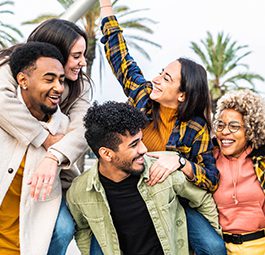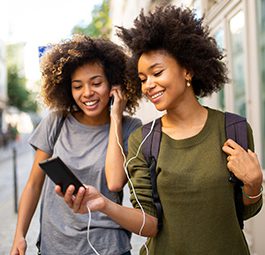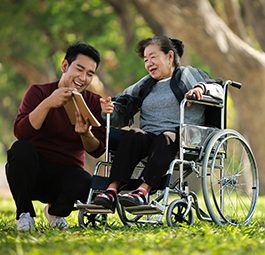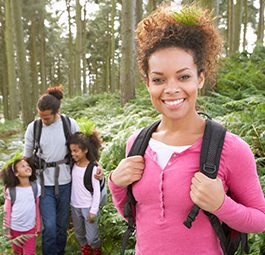Asthma
Resources for Schools & Care Centers
Allergic diseases, such as asthma, food allergies, and atopic dermatitis (eczema), are some of the most common chronic diseases in children in the United States.
- 4.9 million children have asthma
- 4.0 million children have food allergies
- 8.0 million have atopic dermatitis
Asthma is the top reason students miss school. With these numbers, there’s a chance most classrooms in the U.S. will have a student with an allergic disease.
The Asthma and Allergy Foundation of America (AAFA) created this list of resources to help school administrators, nurses, and staff manage asthma and allergies in the classroom.
Emergency Action Plans
Asthma Action Plan (printable PDF)
 This plan has information and instructions on how to manage your asthma. Asthma Action Plans tell school staff and other caregivers about your child’s asthma. You can give it to teachers, school nurses, and afterschool care staff. (Available in English and Spanish)
This plan has information and instructions on how to manage your asthma. Asthma Action Plans tell school staff and other caregivers about your child’s asthma. You can give it to teachers, school nurses, and afterschool care staff. (Available in English and Spanish)
School or Child Care Asthma/Allergy Action Plan (printable PDF)
 This plan has the information you need to care for a young child with asthma or allergies. The plan has sections for information about a medicine plan and a list of the child’s signs and symptoms. It also has steps on how to handle asthma and allergy emergencies.
This plan has the information you need to care for a young child with asthma or allergies. The plan has sections for information about a medicine plan and a list of the child’s signs and symptoms. It also has steps on how to handle asthma and allergy emergencies.
Food Allergy Emergency Care Plan for Children Under Age 3 (printable PDF)
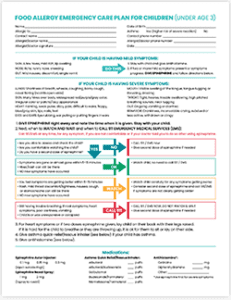 This plan provides information and instructions on how to manage an allergic reaction in children under age 3. It includes symptoms to watch in infants/toddlers, instructions for using epinephrine, and what to do in an emergency. (Available in English and Spanish)
This plan provides information and instructions on how to manage an allergic reaction in children under age 3. It includes symptoms to watch in infants/toddlers, instructions for using epinephrine, and what to do in an emergency. (Available in English and Spanish)
Food Allergy Emergency Care Plan for Children Ages 3 and Up (printable PDF)
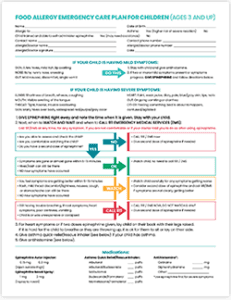 This plan provides information and instructions on how to manage an allergic reaction in children under ages 3 and older (including teens and adults). It includes symptoms to watch in children ages 3 and older, instructions for using epinephrine, and what to do in an emergency. (Available in English and Spanish)
This plan provides information and instructions on how to manage an allergic reaction in children under ages 3 and older (including teens and adults). It includes symptoms to watch in children ages 3 and older, instructions for using epinephrine, and what to do in an emergency. (Available in English and Spanish)
Posters for Asthma and Allergies
Asthma Inhalers (printable PDF)
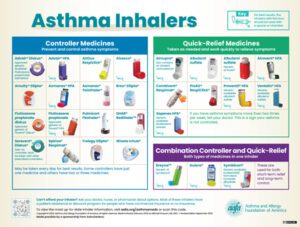 There are different types of asthma medicines and treatments. This handout provides information on current asthma inhalers available in the United States for controller medicines, quick-relief medicines, and combination controller and quick-relief medicines. This handout is also available as an 8.5″x11″ laminated poster, for a cost.
There are different types of asthma medicines and treatments. This handout provides information on current asthma inhalers available in the United States for controller medicines, quick-relief medicines, and combination controller and quick-relief medicines. This handout is also available as an 8.5″x11″ laminated poster, for a cost.
Easy-to-Use Epinephrine Options (printable PDF)
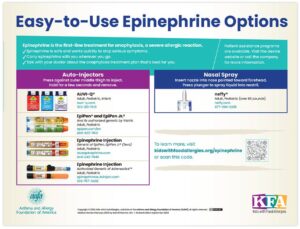 Epinephrine is the first-line treatment for anaphylaxis, a severe allergic reaction. This handout provides information on current epinephrine options (auto-injectors and nasal spray) available in the United States market. This handout is also available as an 8.5″x11″ laminated poster, for a cost.
Epinephrine is the first-line treatment for anaphylaxis, a severe allergic reaction. This handout provides information on current epinephrine options (auto-injectors and nasal spray) available in the United States market. This handout is also available as an 8.5″x11″ laminated poster, for a cost.
Resources for Managing Asthma and Allergies
Asthma can start at any age, even in infancy. But asthma in children can look different than asthma in adults. This can also make it harder to recognize. By knowing how to manage asthma and spot symptoms, you can successfully manage asthma in the children in your care. Learn more about the signs and symptoms of asthma in children.
Asthma Management Education Online (AME-O) (8.75 Contact Hours for Respiratory Therapists and Nurses)
The AME-O course is based on the NAEPP’s “Four Components of Asthma Management” as presented in the National Institute of Health (NIH), National Asthma Education and Prevention Program (NAEPP)’s Expert Panel Report 3 (EPR-3): Guidelines for the Diagnosis and Management of Asthma Summary Report and the 2020 Focused Updates to the guidelines.
Asthma Inhalers (printable PDF)
 There are different types of asthma medicines and treatments. This handout provides information on current asthma inhalers available in the United States for controller medicines, quick-relief medicines, and combination controller and quick-relief medicines. This handout is also available as an 8.5″x11″ laminated poster, for a cost.
There are different types of asthma medicines and treatments. This handout provides information on current asthma inhalers available in the United States for controller medicines, quick-relief medicines, and combination controller and quick-relief medicines. This handout is also available as an 8.5″x11″ laminated poster, for a cost.
Your Guide to Managing Asthma (printable PDF)
 We created this guide to help you know more about managing a child’s asthma. Learn about how asthma is diagnosed, the different levels of asthma, asthma in infants and children, causes and triggers, what happens during an asthma episode, symptoms and treatment, different types of asthma medicine, and managing asthma.
We created this guide to help you know more about managing a child’s asthma. Learn about how asthma is diagnosed, the different levels of asthma, asthma in infants and children, causes and triggers, what happens during an asthma episode, symptoms and treatment, different types of asthma medicine, and managing asthma.
Nebulizers for the Treatment of Asthma (printable PDF)
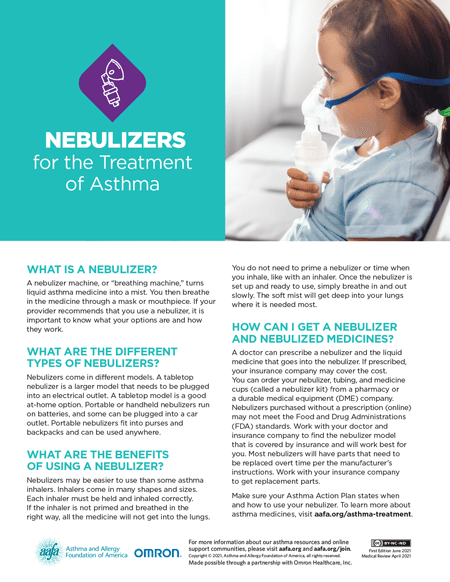 Nebulizers can be used for the treatment of asthma. A nebulizer machine, or “breathing machine,” turns liquid asthma medicine into a mist. You then breathe in the medicine through a mask or mouthpiece. Nebulizers may be easier to use than asthma inhalers for some people. This handout provides information on different types of nebulizers and how to use and clean a nebulizer.
Nebulizers can be used for the treatment of asthma. A nebulizer machine, or “breathing machine,” turns liquid asthma medicine into a mist. You then breathe in the medicine through a mask or mouthpiece. Nebulizers may be easier to use than asthma inhalers for some people. This handout provides information on different types of nebulizers and how to use and clean a nebulizer.
How to Correctly Use Your Asthma Devices (printable PDF)
 Correct inhaler and nebulizer technique helps get asthma medicines into the lungs where it needs to be. This guide outlines the correct techniques for using different asthma medicine delivery devices and equipment, steps on how to clean your asthma medicine devices and delivery equipment, and how to know when your inhaler is empty. (Available in English and Spanish)
Correct inhaler and nebulizer technique helps get asthma medicines into the lungs where it needs to be. This guide outlines the correct techniques for using different asthma medicine delivery devices and equipment, steps on how to clean your asthma medicine devices and delivery equipment, and how to know when your inhaler is empty. (Available in English and Spanish)
Tackle Asthma Playbook (printable PDF)
 AAFA partnered with running back and Dancing with the Stars winner Rashad Jennings to create this game plan so kids can exercise safely with asthma. Follow these steps so you can exercise safely with asthma – including having an Asthma Action Plan, knowing your asthma zones, checking the weather before you exercise outside, always carrying your asthma medicine, preparing your body, and watching for signs of asthma.
AAFA partnered with running back and Dancing with the Stars winner Rashad Jennings to create this game plan so kids can exercise safely with asthma. Follow these steps so you can exercise safely with asthma – including having an Asthma Action Plan, knowing your asthma zones, checking the weather before you exercise outside, always carrying your asthma medicine, preparing your body, and watching for signs of asthma.
Are Asthma and Allergies Disabilities?
Learn how students are protected by the Americans with Disabilities Act if they have asthma and allergies.
Creating an Asthma and Allergy Friendly Environment
AAFA’s State Honor Roll Report
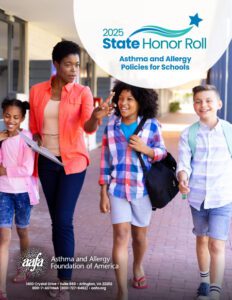 This report by AAFA identifies the states with the best public policies for people with asthma, food allergies, anaphylaxis and related allergic diseases in U.S. elementary, middle and high schools. AAFA checks to see how every state compares against our 27 core policies that affect people with asthma and allergies in schools. Learn more about how your state ranks.
This report by AAFA identifies the states with the best public policies for people with asthma, food allergies, anaphylaxis and related allergic diseases in U.S. elementary, middle and high schools. AAFA checks to see how every state compares against our 27 core policies that affect people with asthma and allergies in schools. Learn more about how your state ranks.
Asthma-Friendly Child Care: A Checklist for Providers (printable PDF)
 This asthma trigger checklist is easy for child care providers to use. It helps them find and control allergens and irritants in their child care center, and provides policies and practices the provider should follow. It can help staff keep their place healthy for the children they serve. Parents can also use this checklist when looking for child care. (Available in English and Spanish)
This asthma trigger checklist is easy for child care providers to use. It helps them find and control allergens and irritants in their child care center, and provides policies and practices the provider should follow. It can help staff keep their place healthy for the children they serve. Parents can also use this checklist when looking for child care. (Available in English and Spanish)
Is It Asthma, Allergies, a Cold, COVID-19, the Flu, or RSV? (printable PDF)
 Because some symptoms are similar, our symptom comparison chart can help determine if staff or a student may be feeling symptoms of asthma, allergies, or a respiratory illness like COVID-19, the flu, a cold, or RSV. You will also find tips on how to help stop the spread of respiratory illnesses. (Download includes English and Spanish)
Because some symptoms are similar, our symptom comparison chart can help determine if staff or a student may be feeling symptoms of asthma, allergies, or a respiratory illness like COVID-19, the flu, a cold, or RSV. You will also find tips on how to help stop the spread of respiratory illnesses. (Download includes English and Spanish)
COVID-19 and Asthma Toolkit for Schools (printable PDF)
 This toolkit and resource guide is designed to help school administrators, nurses, and staff create environments that help protect students and staff with asthma while preventing the spread of COVID-19. This toolkit is designed as a supplement to current local, district and CDC guidelines. The toolkit’s respiratory symptom chart is a quick-reference guide to differentiate between COVID-19 symptoms and other respiratory illnesses and asthma.
This toolkit and resource guide is designed to help school administrators, nurses, and staff create environments that help protect students and staff with asthma while preventing the spread of COVID-19. This toolkit is designed as a supplement to current local, district and CDC guidelines. The toolkit’s respiratory symptom chart is a quick-reference guide to differentiate between COVID-19 symptoms and other respiratory illnesses and asthma.
Back to School with Asthma Toolkit for Schools– American Lung Association (Visit lung.org)
This toolkit offers four key ways schools can create more asthma-friendly learning environments.
Managing Asthma in the School Environment– Environmental Protection Agency (Visit EPA.gov)
This resource from the EPA outlines best practices to reduce asthma triggers and improve indoor air quality in schools. It also includes a resource to teach kids about asthma called, “Dusty the Asthma Goldfish and His Asthma Triggers Funbook.“
Asthma Care in School
School-Based Asthma Management Program – (SAMPRO™) (Visit AAAAI.org)
The American Academy of Allergy, Asthma & Immunology (AAAAI) led a stakeholder workforce that included AAFA to create SAMPRO™. AAFA officially endorses this program. This toolkit was created to improve the care of students with asthma at school. It includes resources to help your school adopt SAMPRO.
National Association of School Nurses (Visit NASN.org)
NASN provides various resources and educational tools to help nurses fulfill their mission to “optimize student health and learning by advancing the practice of school nursing.”
Managing Asthma in Schools – Centers for Disease Control and Prevention (CDC) (Visit CDC.org)
The resource from the CDC includes information on asthma management in schools. With links to “Strategies for Addressing Asthma within a Coordinated School Health Program” and “Asthma-Friendly Schools Toolkit.”
Food Allergy Resources
About 4 million children have food allergies. With these numbers, there’s a good chance many classrooms and care centers in the U.S. will have a student with a food allergy.
Guides to Managing Common Food Allergens
These nine foods cause the most food allergy reactions in the United States:
- Milk
- Eggs
- Peanuts
- Tree nuts (examples: almonds, walnuts, pecans)
- Sesame
- Soy
- Wheat
- Fish (examples: bass, flounder, cod)
- Crustacean shellfish (examples: crab, lobster, shrimp)
Our allergen guides have information about the symptoms of an allergic reaction, preventing reactions, how to read labels, and a list of ingredient names that might appear on labels.
Easy-to-Use Epinephrine Options (printable PDF)
 Epinephrine is the first-line treatment for anaphylaxis, a severe allergic reaction. This handout provides information on current epinephrine options (auto-injectors and nasal spray) available in the United States market. This handout is also available as an 8.5″x11″ laminated poster, for a cost.
Epinephrine is the first-line treatment for anaphylaxis, a severe allergic reaction. This handout provides information on current epinephrine options (auto-injectors and nasal spray) available in the United States market. This handout is also available as an 8.5″x11″ laminated poster, for a cost.
Potential Food Allergens in School Crafts and Activities (printable PDF)
 Common food allergens can be found in arts and craft supplies, as well as many classroom projects and activities. Learn what may contain food allergens, as well as alternatives and precautions. Printable PDF available for free download.
Common food allergens can be found in arts and craft supplies, as well as many classroom projects and activities. Learn what may contain food allergens, as well as alternatives and precautions. Printable PDF available for free download.
Non-Food Rewards for Children With Food Allergies (printable PDF)
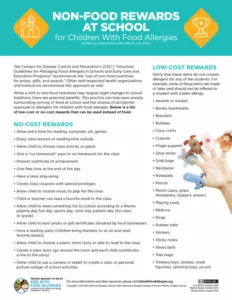 As recommended by the CDC, non-food rewards are great for creating a safe and inclusive classroom. This resource lists several non-food reward ideas and includes a PDF you can print for reference. Printable PDF available for free download.
As recommended by the CDC, non-food rewards are great for creating a safe and inclusive classroom. This resource lists several non-food reward ideas and includes a PDF you can print for reference. Printable PDF available for free download.
Kids with Food Allergies (KFA)
Find more resources on our Kids With Food Allergies (KFA) School Resources for Schools and Care Centers site (Visit kidswithfoodallergies.org)
Fun Ways to Teach Children About Asthma and Allergies
Help kids better understand asthma or food allergies and build compassion for their classmates through fun activity books, videos, online games, and downloadable resources.
Ally & Andy’s Asthma and Allergy Activity Book (printable PDF)
 This coloring and activity book gives children and families a fun way for children to learn common asthma triggers. It also helps them learn how to manage their asthma and food allergies. (Available in English, Spanish, and Arabic)
This coloring and activity book gives children and families a fun way for children to learn common asthma triggers. It also helps them learn how to manage their asthma and food allergies. (Available in English, Spanish, and Arabic)
Medical Review: June 2022 by John James, MD
Updated: March 2024
Managing Asthma and Allergies at School
- School Health Care Plans for Asthma and Allergies
- 504 Plans for Asthma
- School Forms for Asthma
- School Planning Resources for Parents of Children with Asthma & Allergies
- Resources for Schools and Care Centers
- Resources for Early Childhood Education and Child Care
- Managing Asthma and Respiratory Infections in Schools

